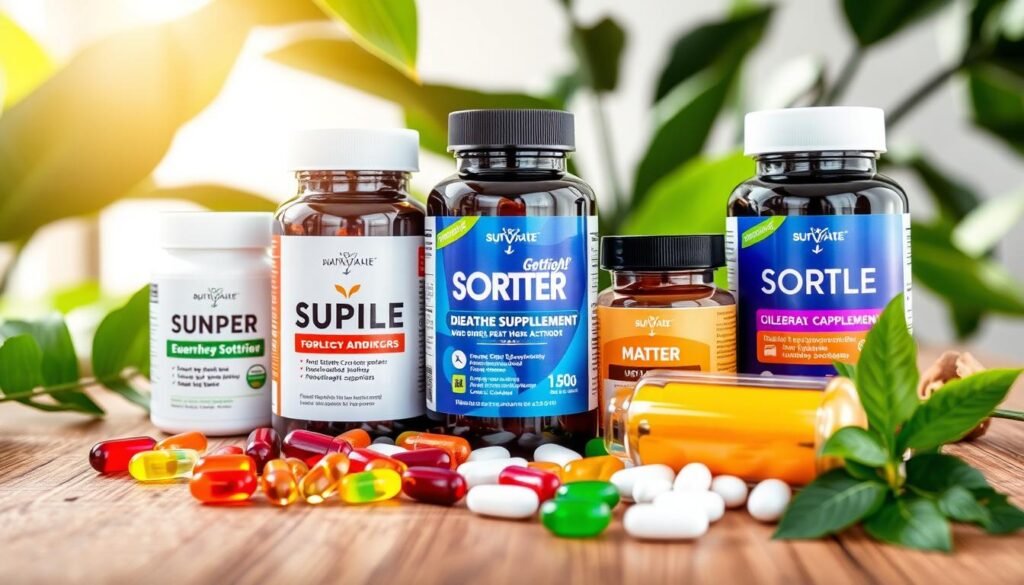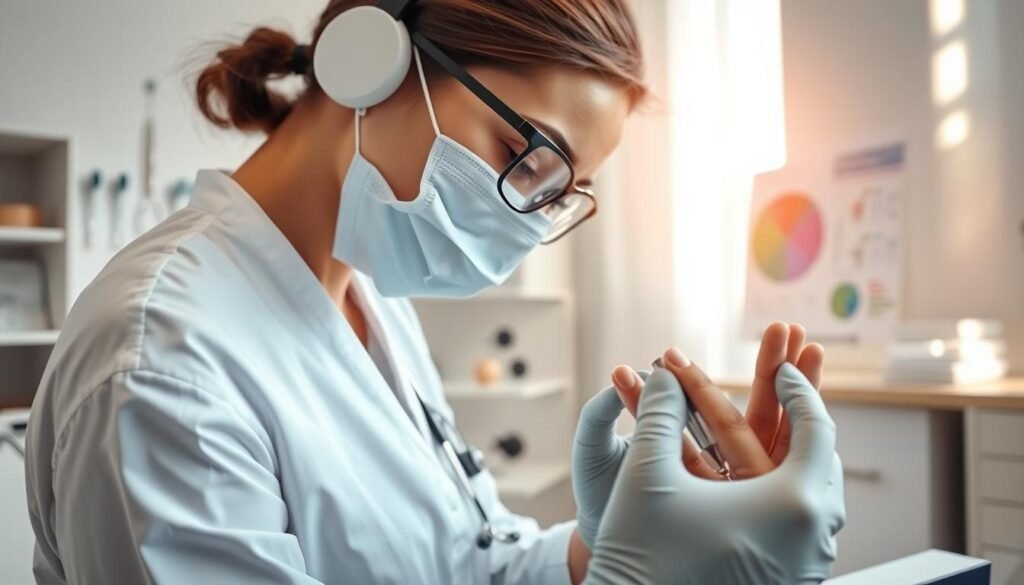Did you know that nearly 42% of adults in the United States lack enough vitamin D? This fact underscores the need to understand its role beyond bone health, extending to nail health. Nails can reveal a lot about our nutritional status, including specific deficiencies that could impact our overall health. Knowing the signs of vitamin D deficiency in your nails is key to keeping them looking good and healthy.
By recognizing these symptoms, you can take steps to boost your vitamin D levels. This action can improve the condition of your nails. And it leads to a healthier lifestyle overall.
Key Takeaways
- How nails can indicate vitamin D deficiency and overall health.
- The significance of recognizing symptoms for proactive health measures.
- The relationship between nail health and nutrient intake.
- Common misconceptions about nails and nutritional deficiencies.
- Understanding the broader implications of vitamin D benefits.
The Importance of Nail Health
Nail health is key to showing how healthy you are. Well-kept nails look smooth, strong, and clear. This suggests a good diet and enough vitamins. On the other hand, unhealthy nails can point to health issues or lack of nutrients.
Vitamin shortages can harm your nails. For example, not having enough vitamins D, B12, A, and C can cause nail problems. A study in 1993 found that biotin helps make nails thicker and stronger. This shows that certain vitamins boost nail health.
Checking your nails can reveal a lot about your body. If you see changes like discoloration, brittleness, or odd growth, it could mean health issues. Paying attention to these signs lets you catch and treat health problems early.
Caring for your nails helps your overall health. It’s about looking and feeling good, inside and out. This approach links diet, lifestyle, and health signs together.
Understanding Vitamin D and Its Benefits
Vitamin D is key for the body, helping with calcium absorption and bone health. It keeps bones strong and lowers osteoporosis risk, especially in women after menopause. Beyond bones, low vitamin D levels link to joint pain and depression.
There are several ways to get vitamin D: sunlight, eating certain foods, and taking supplements. Foods like cod liver oil, rainbow trout, and UV-exposed mushrooms are top sources. Research shows vitamin D-3 supplements might work better in bigger doses than vitamin D-2.
Vitamin D isn’t just for calcium absorption. It also boosts overall vitality. A study found people felt less tired after five weeks of vitamin D supplements. It’s important to check vitamin D levels with blood tests, as deficiencies can sneak up without symptoms. For more on vitamin D’s risks and benefits, read more here.
Recognize the Symptoms of Vitamin D Deficiency in Your Nails
Nail health reflects our overall wellness, so we must recognize the signs. When checking nails, look for specific symptoms of vitamin D deficiency. Brittle and yellow nails are key indicators of nutritional issues.
Identifying Brittle Nails
Brittle nails show if we get enough vitamins, such as vitamin D. They may crack or peel, showing our diet might lack something. Brittle nail syndrome (BNS) happens when nutrition is poor. Affected nails have ridges or split easily. Adequate calcium and vitamin D help keep nails strong. Without them, nails become weak.
What Yellow Nails Indicate
Yellow nails can reveal several health problems. They often suggest not getting enough vitamin D or facing fungal infections. This change in color also could signal more serious issues. Early detection of yellow nails is crucial. It means one should adjust their diet and see a healthcare professional.
| Symptom | Possible Cause | Recommendations |
|---|---|---|
| Brittle Nails | Vitamin D deficiency, nutritional deficiencies | Increase intake of calcium and vitamin D rich foods |
| Yellow Nails | Fungal infection, potential vitamin D deficiency | Consult a dermatologist for evaluation and treatment |
Common Nail Abnormalities Related to Vitamin D Deficiency
Nail problems can point to health issues, like not having enough vitamin D. Spoon nails and grooves across the nail are common signs. Knowing about these can help spot vitamin D issues early. This means getting help sooner.
Koilonychia: Spoon Nails
Spoon nails make nails look like spoons. They often mean you’re low on iron but might also show low vitamin D. People with spoon nails worry about their health. Getting enough iron and vitamin D can make nails better and improve health.
Transverse Grooves
Beau’s lines or transverse grooves are lines across nails. They show stress or a lack of nutrients, like vitamin D. They can happen from being sick or not eating right. If you see these lines, it’s good to check your diet. You might need more nutrients.
The Connection Between Nail Health and Overall Well-Being
Nail health serves as a visible indicator of overall well-being. Brittle, weak, and peeling nails often suggest issues with nutritional intake. These conditions are usually linked to a lack of vitamins and can point to bigger health problems.
Dr. Sara Norris, a naturopathic doctor, points out that poor nutrition or digestion can lead to common nail issues. However, Dr. Mark Benor, notes that while nail issues are not usually signs of serious health problems, they can still cause anxiety.
The link between nail health and vitamin shortages is clear. For example, not getting enough vitamin D can make nails brittle and slow their growth. Also, not having enough of vitamins A, C, and B12 can cause nails to have ridges, turn yellow, and become weak. Drinking enough water is also crucial because dry nails often mean you’re not hydrated enough.
Below, you’ll find a table that connects common nail problems with what you might be missing in your diet:
| Nail Problem | Associated Nutritional Deficiency | Potential Treatment |
|---|---|---|
| Brittle Nails | Vitamin D, Calcium | Increase dairy & mineral intake |
| White Spots | Zinc, Allergic Reactions | Consult a healthcare provider |
| Spoon Nails (Koilonychia) | Iron, Vitamin C | Iron-rich foods & supplements |
| Horizontal Ridges (Beau’s Lines) | Protein, Zinc | Protein intake & dietary changes |
| Yellow Nails | Infection, Thyroid Issues | Medical evaluation & care |
Understanding how your nails reflect your overall health can lead you to pay more attention to your diet. By fixing any vitamin deficiencies, you not only make your nails look better but also take steps towards a healthier, well-balanced diet.
Dietary Sources of Vitamin D
Getting enough vitamin D is key for our health, especially for strong nails and bones. Sunlight is a well-known source of vitamin D. But, we can also get it from certain foods. Fatty fish like salmon and mackerel are great for this.
Egg yolks are also packed with vitamin D and protein, making them good for your health. For those who don’t get much sun, fortified products like milk, orange juice, and cereals are helpful. They are made with extra vitamin D to help those in less sunny places.

Adding these foods to your diet helps keep you healthy. It’s important to eat foods that boost your vitamin D, especially if you’re low on it. Foods rich in vitamin D can make your nails stronger and stop them from breaking or losing color. For tips on nutrition and nail health, check this resource.
Remember, a mix of different vitamins is vital for keeping your nails and bones strong. Combining sun exposure with a variety of vitamin D rich foods gives your body all-around support.
Sun Exposure and Its Role in Vitamin D Production
Sun exposure is key in making vitamin D, which is vital for healthy nails and overall health. UV rays from the sun start a process in the skin that makes vitamin D. Getting enough sunlight ensures our bodies have enough of this important nutrient.
To make enough vitamin D, spending 15 to 20 minutes in the sun three times a week is advised. This should be done when the sun is highest because UVB rays are stronger. Such short periods can produce up to 250 μg (10,000 IU) of vitamin D without causing skin redness. However, too much sun can harm the skin, so it’s wise to be careful.
Our bodies keep vitamin D levels balanced through specific processes. Serum vitamin D3 has a half-life up to 78 hours, and 25(OH)D lasts about 15 days. For good health, 25(OH)D levels should be 75 nmol/L or more. Lack of sun, poor diet, and some health issues can lead to a shortage of vitamin D.
People with problems absorbing nutrients need extra attention for vitamin D. Indoor tanning lamps have helped some people, like those with Short Bowel Syndrome or Cystic Fibrosis, increase their vitamin D. This is especially useful when outdoor sun is scarce, like in winter.
Understanding the role of sun in making vitamin D is crucial. Including foods rich in vitamin D in your diet is also important. Safe sun habits are vital to get the benefits of sunlight without the risks.
| Factor | Impact on Vitamin D |
|---|---|
| Sun Exposure | Key source for vitamin D production; 15-20 minutes can yield up to 250 μg (10,000 IU) |
| Diet | Provides vitamin D from foods like salmon, mushrooms, and egg yolks |
| Health Conditions | Malabsorption syndromes can reduce vitamin D intake efficiency |
| Supplementation | Should be considered only under medical guidance to avoid toxicity |
Dietary Supplements to Consider
Nails need more than just good food to stay healthy. Supplements can make a big difference. When it’s hard to get enough vitamin D from the sun or food, vitamin D supplements help a lot. They come mostly in D2 and D3 forms, but D3 works better for increasing vitamin D levels in blood.
Vitamin D is crucial for keeping nails in good shape. Not having enough can make nails weak and slow to grow. Adding dietary supplements to your daily routine can meet your needs. They might fix problems that hurt your nails. Before starting, talking to a doctor for advice based on your own health is smart.

B12 and C vitamins are also important for nail health. Research shows that fixing low levels of these vitamins with dietary supplements improves nail condition. There are many types of supplements out there. Some are multivitamins, which include many nutrients for improving health.
| Vitamin | Deficiency Symptoms | Supplement Form |
|---|---|---|
| Vitamin D | Brittle nails, slow growth | Vitamin D2, Vitamin D3 |
| Vitamin B12 | Weak, brittle nails, yellow coloration | Subcutaneous B12, oral tablets |
| Vitamin C | Weak, splitting nails | Ascorbic acid, chewable tablets |
Want to know how to spot lack of vitamins in your nails? Check out this Signs of Vitamin Deficiency in Nails.
Recognizing Other Symptoms of Vitamin Deficiency
Vitamin deficiencies show up in many ways, not just through our nails. We should watch for other symptoms that might hint at a deficiency. Signs to look out for include feeling tired, issues with skin, and mood swings. Often, a lack of Vitamin D can go unnoticed because its signs are subtle. However, not addressing it can lead to bigger problems.
About 95% of people in the U.S. don’t get enough Vitamin D, says the National Health and Nutrition Examination Survey (NHANES). This shortage can cause serious issues, like low calcium levels and secondary hyperparathyroidism. Symptoms of not getting enough vitamins can vary widely:
- Fatigue: Often due to not having enough B12 or iron, which are crucial for energy.
- Skin Problems: Lacking in Vitamin A and B can lead to skin issues, including poor healing signs.
- Cognitive Changes: A B12 shortage can result in confusion and memory problems, affecting mental health.
Nails are only one way our body signals its nutritional health. For instance, not getting enough vitamin C might lead to gingivitis or hair loss. Also, a potassium deficiency can make you feel tired or weak. So, paying attention to these changes is key for our nutrition.
Seeking information from reliable sources can teach us a lot about nutrient deficiencies and health. You can learn more by reading this relevant article. Taking steps early to address these deficiencies can lower the risk of long-term health issues.
Consulting a Healthcare Professional
When people see changes in their nails, talking to a healthcare pro is key. They can help figure out what’s going on and check for health problems. Doctors might test for vitamins and minerals that keep nails strong.
Trying to figure it out yourself can lead to wrong solutions. Brittle nails may mean you need more vitamin D, which helps with strong nails. If you’re lacking, a pro might suggest eating differently, taking vitamins, or doing other tests.
Regular talks with a healthcare pro keep you ahead in staying healthy. Knowing about your nail health can tell you a lot about your body’s condition. It shows how important it is to eat well and have check-ups. Getting help early stops small problems from getting bigger.

Conclusion
Knowing how to spot vitamin D deficiency is key to keeping nails healthy. It also matters for overall health. Nails can tell us a lot about what our bodies need. If they are weak or look different, it might be time to eat more foods rich in vitamin D.
A healthy diet and enough sunlight are important. They help our nails, our immune system, and our overall health. Some people, especially women, might not get enough important vitamins. They should try to get more nutrients in their diet.
Understanding how vitamin D affects our nails and health is important. We should make smart choices based on this knowledge. If you’re worried about your health, talking to a doctor can help. It can lead to better health and more energy.



